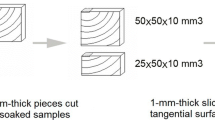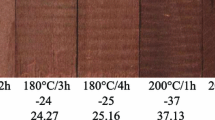Abstract
Thin strips of pine and lime were exposed to deionised water in the temperature range 50–90°C. Losses in wet tested tensile strength and toughness occurred rapidly at 65°C. Dry tested specimens and those tested wet but at zero-span retained a much higher proportion of their original strength. Scanning electron micrographs revealed that these specimens failed mainly by intra-fibre fracture, whereas specimens tested wet but at finite span showed marked interfibre shear failure. Strength losses in water saturated with nitrogen and in water saturated with air were similar and strength losses in the absence of water were small. pH measurements on water solutions revealed a marked increase in acidity during exposure.
Zusammenfassung
Proben aus Kiefer und Linde wurden deionisiertem Wasser bei Temperaturen von 50 bis 90°C ausgesetzt. Bei 65°C traten rasch Verluste der im feuchten Zustand getesteten Proben hinsichtlich Zugfestigkeit und Zähigkeit auf. In trockenem Zustand geprüfte Proben und naß geprüfte, jedoch bei einer „freien Einspannlänge” von null, behielten einen wesentlich höheren Anteil ihrer ursprünglichen Festigkeit. Raster-Elektronen-Mikroskopiebilder zeigten, daß diese Proben meist in der Faser selbst brachen, während die naß getesteten mit einer bestimmten freien Einspannlänge einen deutlichen Scherbruch zwischen den Fasern erkennen ließen. Festigkeitsverluste in Stickstoff-gesättigtem und in Luft-gesättigtem Wasser waren ähnlich hoch, Festigkeitsverluste in Abwesenheit von Wasser niedrig. pH-Messungen des verwendeten Wasser ließen einen deutlichen Anstieg des Säuregrades während der Exposition erkennen.
Similar content being viewed by others
Literature
Ashton, H. E. 1967: Clear finishes for exterior wood, field exposure tests. J. Paint Technol. 39:212–224
Carey, J. K. 1982: Assessing the performance of preservative treatments for wooden joinery. Holz Roh-Werkstoff 40:269–274
Derbyshire, H.; Miller, E. R. 1981: The photodegradation of wood during solar irradiation. Part 1: Effects on the structural integrity of thin wood strips. Holz Roh-Werkstoff 39:341–350
Hawley, L. F.; Wiertelak, J. 1931: Effect of mild heat treatments on the chemical composition of wood. Ind. Eng. Chem. 23:184–186
Koran, Z. 1967: Electron microscopy of radial tracheid surfaces of black spruce separated by tensile failure at various temperatures. Tappi 50(2):60–67
Kürschner, K.; Melcerova, A. 1965: Über die chemischen Veränderungen des Buchenholzes bei thermischer Behandlung—Teil 1: Chemische Veränderungen von Sägespänen bei 1–28 tägiger Erhitzung auf 80–160°C (Chemical changes of beechwood during thermal treatment. Part I: Chemical changes of sawdust heated 1–28 days at 80–160°C). Holzforschung 19:161–171
Maclean, J. D. 1954: Effect of heating in water on the strength properties of wood. Proccedings American Wood Preservers Assoc. 50:253–281
Miller, E. R.; Boxall, J. 1987: The effectiveness of end-grain sealers in improving paint performance in softwood joinery. L-joint results after 4 years natural weathering. Holz Roh-Werkstoff 45:69–74
Nie, N. H.; Hull, C. H.; Jenkins, J. G.; Steinbrenner, K.; Bent, D. H. 1975: SPSS-Statistical package for the social sciences, 2nd Ed. New York: McGraw-Hill
Packman, D. F. 1960: The acidity of wood. Holzforschung 14:178–183
Voulgaridis, V.; Banks, W. B. 1981: Degradation of wood during weathering in relation to water repellant long-term effectivenss. J. of Inst. Wood Sci. 9:72–83
Wengert, E. M. 1966: Parameters for predicting maximum surface temperatures of wood in exterior exposures. U.S.D.A. For. Res. Pap. FPL 61:1–16
Author information
Authors and Affiliations
Additional information
The authors wish to thank the Science and Engineering Research Council (U.K.) for the funding of this work which was conducted at the Department of Forestry and Wood Science, University College of North Wales, Bangor.
Rights and permissions
About this article
Cite this article
Evans, P.D., Banks, W.B. Degradation of wood surfaces by water Changes in mechanical properties of thin wood strips. Holz als Roh-und Werkstoff 46, 427–435 (1988). https://doi.org/10.1007/BF02608208
Issue Date:
DOI: https://doi.org/10.1007/BF02608208




